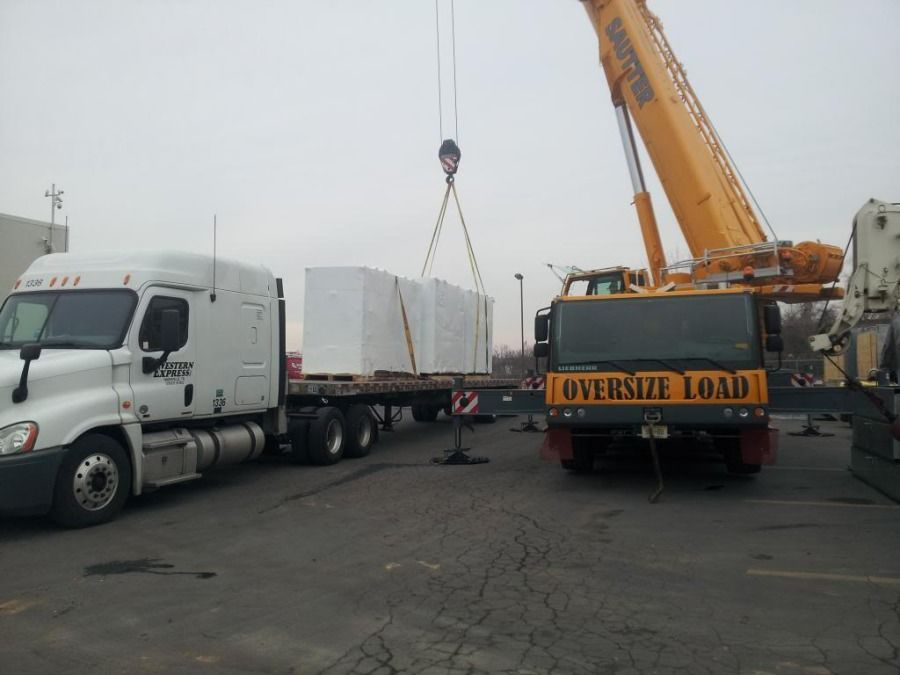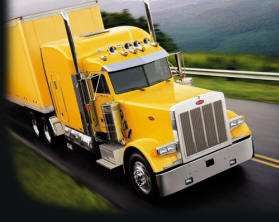Taking A Look At Securing A Flat-Bed Load
Topic 3287 | Page 2
Here forward is 1x the mass, sideways .5 the mass, rearwards .5 the mass and vertical is .2 the mass.
Kiwi, I find the differences in our systems intriguing. In the U.S. forward is .435 (which considering that our figure is based on a WLL of 1/2 the total weight that makes our figures really close to yours, if I'm understanding it correctly) our lateral measurement would be .25 (which again correlates with your numbers) and our rearward measurement is .5. I don't recall ever having a vertical measurement.
Off the top of my head I can't recall the calculations for a Static Roll-over Threshold - You make me realize I might need to refresh some of this information in my head.
Here's a few photos of us unloading this load today. It was a really fun day. Grown men are such simple creatures - just let us play with our big heavy duty high dollar toys while we are doing our daily tasks, and we will be just as happy as a couple of little kids in a sandbox pushing dirt around with their Tonka Toys!


Everything went off just fine today, and when I sent in my empty call it couldn't have been more than ninety seconds when my Qualcomm started barking at me to let me know I had a 1,000 mile load going from New London CT to Milwaukee WI.
Qualcomm:
Omnitracs (a.k.a. Qualcomm) is a satellite-based messaging system with built-in GPS capabilities built by Qualcomm. It has a small computer screen and keyboard and is tied into the truck’s computer. It allows trucking companies to track where the driver is at, monitor the truck, and send and receive messages with the driver – similar to email.
Old School,
You were in New London...I was in Waterford today for my first day at school, so close!!
Hey I loved the detail and pics in this post, great stuff!!
I've never even gone through the Federal regs on it. I'm gonna have to take a look at em....
Hey Brett, a great place to start is 392.9 - then just keep on reading - most people would find it kind of boring, but I agree with your idea of how to approach a training module. I've always tried to pair my examples of this stuff with real world experiences and people usually find it a lot more interesting that way. It's much like the weights and balances section. When people see how it works and how it will make there job more efficient and productive it becomes something you really want to understand so you can utilize it to be a better truck driver. Kind of like what the fella said the other day that I just loved when he said "now that I've learned to drive a truck, it's time for me to learn to become a truck driver", or something to that effect. It is definitely valuable knowledge that, once learned, comes fairly easy to someone who is putting it into practical use on a daily basis.
CDL:
Commercial Driver's License (CDL)
A CDL is required to drive any of the following vehicles:
- Any combination of vehicles with a gross combined weight rating (GCWR) of 26,001 or more pounds, providing the gross vehicle weight rating (GVWR) of the vehicle being towed is in excess of 10,000 pounds.
- Any single vehicle with a GVWR of 26,001 or more pounds, or any such vehicle towing another not in excess of 10,000 pounds.
- Any vehicle, regardless of size, designed to transport 16 or more persons, including the driver.
- Any vehicle required by federal regulations to be placarded while transporting hazardous materials.
Jim, I'm spending the night at the TA on 95 at Branford.
Hey Brett, a great place to start is 392.9 - then just keep on reading - most people would find it kind of boring, but I agree with your idea of how to approach a training module. I've always tried to pair my examples of this stuff with real world experiences and people usually find it a lot more interesting that way. It's much like the weights and balances section. When people see how it works and how it will make there job more efficient and productive it becomes something you really want to understand so you can utilize it to be a better truck driver. Kind of like what the fella said the other day that I just loved when he said "now that I've learned to drive a truck, it's time for me to learn to become a truck driver", or something to that effect. It is definitely valuable knowledge that, once learned, comes fairly easy to someone who is putting it into practical use on a daily basis.
I completely agree with everything you said and I'm definitely going to take a look through that literature. If the literature is really thorough and put together well I can use it to build the core of the module. Then I'll need experienced hands like yourself to polish it off by adding some tips, tricks, and real-world knowledge to make it applicable to everyday life out there.

Hey, question for you guys . . . since flatbeds are open and the load is obvious, how much info about a refer load or a dry van load does the driver have to know . . . especially if the driver hooks up to a pre-loaded trailer, how much does he have to know about HOW it was loaded beside weighing out the axles to see how it is distributed . . . does the driver normally do a quick inspection of the contents and make a judgement about the stability of the load or does he/she more or less "trust" that the people who loaded it are good at what they do and conscientious about making sure the load is stable and not prone to move in case of some event down the road?
Jopa

Dry Van:
A trailer or truck that that requires no special attention, such as refrigeration, that hauls regular palletted, boxed, or floor-loaded freight. The most common type of trailer in trucking.
The round spools between the rail and the trailer deck are designed to have the chain wrapped around them. They are intrinsically stronger than the stake pockets, by the fact that they are round, and welded all the way around on both ends. The stake pockets tear easily when a load is placed on them, like from a panic stop, or a long cheater bar and a snap binder or ratchet binder. Our safety dept. got a clarification on this from the East Corp.
Jopa, often times a reefer load will already be sealed when you get there to pick it up. I always know what's going on back there on my trailer. Even the other night while I was waiting in the dark out on the street at a shipper in Cincinnati, all of a sudden I felt my tractor kind of start wiggling around. I immediately flipped on the utility light on the back of my tractor, got out and looked back at my trailer to see four little Hispanic children back there dancing around in a circle on top of my trailer deck - I guess they were doing the flat-bed-boogie or something like it. Hopefully Daniel will jump in here and give you a better answer to your questions, because I don't know what he does if he discovers four little kids in his trailer.
Shipper:
The customer who is shipping the freight. This is where the driver will pick up a load and then deliver it to the receiver or consignee.
Reefer:
A refrigerated trailer.
New Reply:
New! Check out our help videos for a better understanding of our forum features

















Preview:
This topic has the following tags:
Driver Responsibilities Flatbed High Road Training Program Load Securement Photos Safe Driving Tips Understanding The Laws







 TT On Facebook
TT On Facebook
Here forward is 1x the mass, sideways .5 the mass, rearwards .5 the mass and vertical is .2 the mass.
The basic restraint regulations here are pretty simple too, where it gets complex is the appendix tables of permitted restraint types, ratings and securements. For my Class 2 currently I only need straps, but I'm starting to study the chain and cable regs for my Class 4/5 licence tests.
What are your SRT limits? Here they must pass a .35 SRT limit, with corners posted for a SRT of .22
Translated, in case you call SRT something else. that is Static Rollover Threshold, a theoretical calculation of the point of rollover. A truck in NZ must be loaded to survive taking a corner which creates a sideways force of .35 gravities at the top of the load, while corners are engineered and speed limits posted so as cornering at the posted speed would create a force acting sideways against the truck at the top of the load of .22g
Sports cars can manage over 1.5g, supercars like the Ferarri Enzo can manage around 2.1g, but trucks are far less stable, and MUCH taller for their weight.